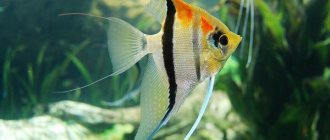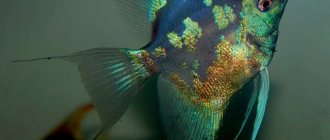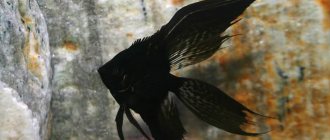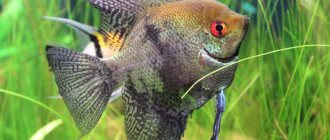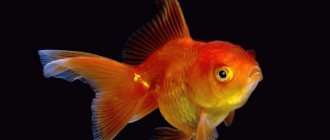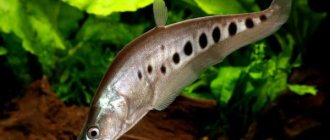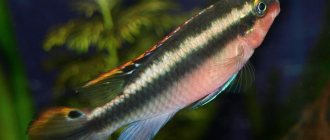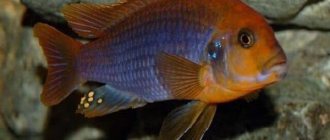by fisher October 26, 2017 0 Comments
Family: Cichlids
American cichlids
Altum (Pterophyllum altum) is one of three species of pterophyllum. The most famous and popular of which is without a doubt the angelfish. From which the altum differs in appearance, being larger, slimmer and taller, it has a steeper forehead and a pronounced snub nose. External differences are especially noticeable in juveniles, which differ from their peers in other species by their magnificent long fins. Other less noticeable external features, but used by taxonomists in the scientific description of the species, include a greater number of fin rays, rows of scales and lateral linear pores than in angelfish.
Altums by four dark, sometimes almost black (depending on mood and condition) vertical stripes. The number of which, during stress, can increase to seven. The newly appeared stripes are paler in color and appear in the spaces between the main ones.
Pterophyllum altum
In a one-year-old altum, greenish-blue structured frontal and dorsal areas become noticeable. The spaces between them are painted red-brown.
Like other species of pterophyllum, in an excited state, a clearly visible black spot (excitation spot) appears behind the eye, connecting to the first vertical stripe.
The species was first described by Pelegrinni in 1903.
As mentioned earlier, altums are the largest species of all pterophyllums; the span of their dorsal and anal fins can reach 35-40 cm.
General information
The high-bodied angelfish, or altum angelfish (Pterophyllum altum) is a freshwater tropical fish from the Cichlid family. Along with the common angelfish and Leopold's angelfish, it forms the triad of the genus Pterophyllum. The species was described by French zoologist Jacques Pellegrin in 1903. "Altum" translated from Greek means "high", which reflects the main difference between this species and other angelfish - its strongly elongated body. With fins, the size of some individuals can reach 40 cm.
Altum angelfish can decorate any large aquarium. Their movements are graceful and easy. The first specimens introduced into amateur aquariums were caught in the wild. The cost of the fish was quite high. Even in our time, despite the success in breeding these majestic fish, “savages” can be found on sale.
The span of altum fins can reach 40 cm
Altum angelfish are similar to common angelfish, which can sometimes lead to confusion. It is especially difficult to distinguish altum from some specimens of angelfish living in the Rio Negro basin, which have an elongated body and a slightly protruding muzzle. Unfortunately, this plays into the hands of dishonest merchants who pass them off as real Altums and sell this species at a price ten times higher.
Altums are very hardy fish; with the correct technology of transfer to an aquarium, even among natural specimens, losses are minimal. The fish spend most of their time in the middle layers of water, but they can easily take food both from the surface and at the bottom.
Sexual differences between female and male angelfish
It is almost impossible to distinguish a male from a female angelfish just by looking at them. Since their sexual dimorphism is not clearly expressed. Except if the female is ready to breed.
Both sexes have an organ, the gonopodium, located between the anal and ventral fins. When the female is ready to reproduce, her gonopodium becomes slightly enlarged and has a blunt tip. In a mating male, the organ also enlarges, but becomes sharper. This is the main distinguishing feature between male and female angelfish. However, it is not always 100% reliable.
There is data in the literature on how to distinguish a female from a male angelfish by the forehead and angles of the fins. However, it is not a fact that this is all true.
However, there is one sure sign. If a fish lays eggs, it is a female.
Who are the Rio Negro Altums?
Very often, the real altum angelfish is confused with the common angelfish because of their external similarity. This confusion occurs even in stores selling angelfish. It is important to understand that these two species of the genus Pterophyllum are found in different rivers. Sometimes among the common angelfish found in the tributaries of the Amazon and Rio Negro, there are specimens with a tall body and a slightly protruding muzzle. Because of this similarity, such specimens are often called angelfish altum, but in fact they are ordinary angelfish, for which the name “Rio Negro altum” is used.
True altums live only in the Orinoco River, and are not found in the Amazon and its tributaries. As for their appearance, the shape of the muzzle is very characteristic, noticeably different from that of the common angelfish.
Photos of breeding forms of angelfish
Zebra
Halfblack Silver Angelfish
Golden pearl angelfish
Blue
Angelfish Koi
In addition to the above, we must not forget to mention:
- Platinum.
- German red.
- Black hybrid.
- Leopardra.
- Marble.
- Golden.
- Chocolate.
- Albino.
Appearance
Altum angelfish have a large and slender body. The anal and dorsal fins of fish are much more elongated than those of other species of angelfish; their span can reach 40 cm. The most obvious difference between altums is the pronounced saddle-shaped depression in the forehead.
Angelfish altum. Appearance
Four dark, almost black stripes are clearly visible on the body of Altums. Their intensity depends on the mood of the fish and the environment. During times of stress, additional, paler stripes may appear between them. If the altum angelfish is excited, a dark spot appears behind the eye. This is observed in all representatives of the genus.
The lifespan of fish at home is 10-12 years.
Sexual dimorphism
to reliably determine the sex of altums only during the spawning period. The rest of the time, secondary sexual characteristics do not provide a one hundred percent guarantee. Thus, adult males are somewhat larger than females, taller and more steep-faced, and they also have a more contrasting coloration. But all this is quite relative and highly depends on the conditions of detention.
Often, belonging to one or the other sex can be judged by the size of the fins. Thus, males have two or more elongated rays at the end of the anal fin, while females have only one such ray. The sex of fish can be determined by behavior, but this requires some experience in keeping altums .
Content
Angelfish are quite unpretentious fish and can live more than 10 years if they are provided with suitable conditions. Due to their shape, tall aquariums with a volume of at least 120 liters are preferred. However, if you are going to keep several of these beautiful fish, it is better to get an aquarium of 200-250 liters or more. Another benefit of buying a spacious aquarium is that it makes parents feel calmer and does not eat their eggs as often. Keep in warm water, at a water temperature in the aquarium of 25-27C. In nature, they live in slightly acidic, fairly soft water, but now they adapt well to a variety of conditions and parameters. The decor in the aquarium can be anything, but preferably without sharp edges that could injure the fish.
Angelfish can pluck tender plants, but not very severely. In my case, they persistently eat Eleocharis, although they are never hungry and regularly eat food with plant components. And they defeated their attempt to attach moss to a snag very easily. Regularly plucking Java moss one branch at a time. It’s difficult to say why they behave this way, but, apparently, out of boredom and a voracious appetite. It is advisable to plant plants with wide leaves in the aquarium, such as nymphs or Amazons; they like to lay eggs on such leaves.
The body structure of aquarium angelfish is not adapted to swimming in strong currents, and filtration in the aquarium should be moderate. A large flow of water causes stress and slows down the growth of fish as they spend energy fighting it. It is wise to use an external filter and supply water through a flute or an internal one and spray the flow. Weekly water changes are required, about 20% of the volume.
Reproduction of a biotope for keeping Altum angelfish
Today, a large amount of information has been collected about the natural habitat of the species P.altum. To successfully keep individuals in an aquarium, it is necessary to summarize the information received.
40 liters of water is enough for one adult.
Water indicators - pH 4.5-5.5; electrical conductivity 0.5-0.15; temperature 28.9 (28.3-30°C); temperature during drug treatment 31-32°C; high dissolved oxygen concentration (adequate mixing)
Substrate – white river sand, 1-2 mm, eroded, round, smooth. Decoration using tree branches (oak, mahogany, cherry).
In order to naturally lower the pH and soften the water, peat moss, T. catappa (Indian almond leaves - Ketapang), alder cones, and a similar organic substrate are added to the water. However, the water should never be so dark that you cannot see the fish. If the pH cannot be reduced naturally, add sulfuric or hydrochloric acid. Use the aqueous acid solution very carefully.
It is better to cover the side and back walls of the aquarium. In the aquarium, they achieve dim lighting and recreate the forest canopy.
It is necessary to ensure strong aeration and mixing of water. Altums, more than discus fish, prefer strong currents.
Breeding
Angelfish form a stable, monogamous pair, and they actively spawn in a common aquarium, but it is quite difficult to preserve eggs. As a rule, eggs are deposited on vertical surfaces: a piece of driftwood, a flat sheet, even on glass in an aquarium. For propagation, special devices are often installed, either cones, or a piece of plastic pipe, or a ceramic pipe. Like all cichlids, angelfish have developed care for their offspring. Reproduction is not easy spawning, the parents take care of the eggs, and when the fry hatch, they continue to care for them until they swim.
Since angelfish choose their own mates, the best way to get such a mate is to buy six or more fish and raise them until they decide. Very often, the aquarist only learns about the beginning of spawning when he sees eggs in one corner and all the inhabitants of the aquarium in another. But, if you are careful, you can see a couple that is preparing to breed. They stick together, drive away other fish, and guard a secluded corner in the aquarium. Angelfish usually reach sexual maturity at 8-12 months, and can spawn every 7-10 days if taken from them. Spawning begins with the couple choosing a place and beginning to methodically clean it. The female then lays a chain of eggs, and the male immediately fertilizes them. This continues until all the eggs (sometimes several hundred) have been laid; the angelfish eggs are quite large and light in color.
Reproduction of altums in an aquarium
Like most other species of cichlids, altum in nature is determined by seasonal cycles. Therefore, even in an aquarium, it is recommended to plant them for spawning from April to June. Usually at this time, pairs are formed, which separate from the main group, occupy a certain territory and protect it from uninvited guests. This behavior occurs in fairly large aquariums. At this point, a couple of breeders can be placed in a separate aquarium, or they can be left in a familiar environment, which is preferable, since altums (especially wild ones) are more timid than discus.
In the absence of opposite-sex partners, false spawning sometimes occurs when two same-sex individuals imitate a pair.
To stimulate spawning, you will need to adjust the water parameters. For successful spawning, the water must be soft and highly acidic. The following indicators can be considered optimal: electrical conductivity - from 100 to 150 mS/cm, pH - from 5.5 to 6.0.
The diet at this time should be as varied as possible, but moderate in volume.
As a rule, the separated pair chooses a side glass or a large leaf of a plant as a substrate for spawning. You can additionally offer manufacturers ceramic cones or pipes, objects with a flat surface, and even sections of PVC plumbing pipes with a diameter of 40 to 50 mm.
A pair of breeders becomes very aggressive towards other fish in the aquarium, as evidenced by certain external signs. Their coloring during this period becomes very contrasting, including a black spot behind the eye. This color change indicates impending spawning.
If the female has a fairly noticeable ovipositor (2-3 mm thick and 4 mm long), and the male has a pointed genital papilla (3 mm long), then no more than two days are left before spawning. During this period, if possible, you should not make noise or make sudden movements near the aquarium.
Producers begin to actively clean the substrate chosen for spawning. As spawning approaches, the behavior of altums changes; they begin to show signs of attention to each other, expressed in the straightening and slight trembling of their fins and circling around each other.
Usually around noon, the female begins to lay eggs, which are immediately fertilized by the male. The female lays eggs in a cord-like manner: from bottom to top, with the eggs located very close to each other. Spawning lasts about an hour and a half. During which the female is able to lay from 300 to 500 eggs. The clutch is considered fertilized if, after a few hours, a white cap becomes noticeable on the laid eggs, indicating the development of the embryo. The laid eggs are almost transparent, with a slight yellowish tint. Having laid the eggs, the producers take turns caring for the eggs, vigorously fanning them with their pectoral fins and removing particles of dirt from the eggs. Often in an aquarium, after just a few hours the first eggs become cloudy and die, and after a day the clutch dies completely.
Such a sad ending can be caused by two reasons: the first is that the water is too hard for the development of eggs, the second and more probable is the presence of a large number of pathogenic microorganisms in the water.
Even transferring eggs from a community aquarium or spawning tank to a specially prepared container with a small amount of bacteria may not be effective if the eggs have been exposed to negative effects for more than 90 minutes. Even if individual eggs do not die and larvae emerge from them, most likely they will have various physical defects.
To obtain the maximum number of juveniles, immediately after spawning, transfer the clutch from the spawning tank to another container.
To obtain high-quality water in such an aquarium, you should use an internal filter with peat filler. Moreover, the amount of peat should not be large, sufficient only to stabilize the acidity of the water. It is recommended to use the finest quartz sand as a soil, laid in a layer of 0.5-1 cm, which promotes the development of beneficial microflora.
Adding antibacterial drugs to water is possible, but this does not always lead to the desired result. The use of ultraviolet sterilizers is also ineffective.
The best solution for disinfecting water is pumping ozone through an air compressor.
After about 60 hours, the larvae hatch, hanging on the substrate or sinking to the bottom. After resorption of the yolk sac, the fry are about 5 mm in size and begin to swim in a school throughout the aquarium in search of food. At this time they should begin to be fed with the smallest live food.
The most critical are the first three days after starting nutrition. For good growth of fry, a sufficient volume of water, multiple feedings, good filtration and frequent water changes are necessary. The so-called Hamburg filter has proven itself to be an excellent filter.
At 10-12 days, the appearance of the fry begins to change. Altums , like discus, experience upward growth during this period, which determines the future shape of the body . Every day the fry begin to look more and more like adult fish, their fins grow, and their body takes on the shape typical of pterophyllums. On the 18th day, vertical stripes begin to appear in the fry.
When the span of the Altum's reaches 4 cm, they should be transplanted into a more spacious aquarium.
For proper rearing of juveniles, the stocking density should be 40-50 individuals per 100 liters of water. Now the fry’s diet can include everything they can swallow: crushed bloodworms, large brine shrimp, water fleas.
The amount of food should be such that the fry eat it within ten minutes. The optimal number of feedings is 5-6 times a day.
Residues of food and fish waste products should be periodically sucked out of the aquarium, combined with partial water changes (50 volumes, twice a week). This is necessary to minimize the amount of pathogenic microflora in the water.
In general, altums grow more evenly than angelfish. In this case, the size of the aquarium plays a big role. Gradually, the grown juveniles are transferred to tap water with a pH of 7.5, carbonate hardness of 4 dKH and electrical conductivity of 280 mS/cm. Maintaining the temperature in the aquarium at 28°C.
At one year of age, the span of the fins of altums kept in optimal conditions can reach up to 20 cm, and upon reaching sexual maturity (after 2 years) - 30 cm. In spacious and high aquariums, by 3 years, this figure can increase to 35-40 cm.
Like discus, altums are very sensitive to intestinal diseases and infections caused by bacteria settling on their epidermis. Only the development of the disease in altums takes a little longer than in discus.
Many negative factors, including improper nutrition and keeping them at low temperatures, can pose a great danger to the life of these fish.
To date, the world has collected enough information about the natural habitat of altums . Therefore, to successfully keep and breed these beautiful fish, you should summarize and use this accumulated information.
Habitat
The boundaries of the natural habitat of Altums are still not fully described. It can be stated with certainty that the species lives throughout the entire space from the Orinoco and Rio Negro rivers to the Amazon. It is very likely that the ranges of the altum and the common angelfish overlap, and it is even possible that natural hybrids may appear in this area.
There are fish in reservoirs with both black tropical water and light waters, but they prefer the former. The water here is soft and acidic due to the large amount of rotting organic matter from the litter of tropical rainforests. They love moderate currents and water rich in oxygen.
Altum angelfish live in small groups of 5-20 individuals. They prefer areas near the shore at depths of up to 3 meters with dense thickets of aquatic vegetation and snags, which serve as natural shelter.
Angelfish in their natural habitat
The first description of angelfish was made by researcher Schulze back in 1823. The fish came to Europe in 1920, and already in 1930 it was successfully bred in the USA. Although modern fish of this family are called common, and they are not difficult to find on sale, they differ significantly from their natural relatives.
In nature, angelfish live in South American reservoirs with slow currents. Their homeland is considered to be the central Amazon and its tributaries in Peru, Brazil, and eastern Ecuador. Under natural conditions, angelfish need a pond with a small amount of plants; their food is fry, insects, invertebrates, and vegetation.
Compatibility
Altum angelfish are distinguished by their peaceful disposition, but do not forget that they are still cichlids, and this species also has the rudiments of hunting instincts. The ideal option would be a species aquarium in which the fish can demonstrate all their beauty.
Large characins will be good neighbors: ornathus, lemon tetras, rubrostigmas, minors, viviparous fish: swordtails, mollies. Corydoras, ancistrus and thoracatum catfish are also well suited for keeping together.
Angelfish altum in a community aquarium
You should not add fish to altums whose adult size does not exceed 4 cm (microrasboras, otocinclus, etc.). Sooner or later, angelfish may start hunting them. But when trying to swallow prey, it easily gets stuck in the fish’s mouth, which can cause their death.
Of course, you cannot keep Altums with large predatory fish, which can not only bite their luxurious fins, but also beat the angelfish to death.
Feeding Altums
The natural diet of Altums is quite varied. It includes insects, worms, crustaceans, and fry of other fish. For this reason, many aquarists prefer to feed their fish with live or frozen foods such as bloodworms, brine shrimp, and tubifex. Such foods cannot fully satisfy the nutritional needs of altums, and, moreover, carry a potential threat of contamination of the aquarium. It is strictly not recommended to feed tall angelfish with minced meat from warm-blooded animals (for example, beef); fish do not have specific enzymes for digesting this type of meat.
The ideal solution for feeding Altum at home is high-quality dry food. They are fully balanced, contain a complex of vitamins and prebiotics, are perfectly digestible and reduce the amount of fish waste, which allows you to maintain clean water in the aquarium.
Altum angelfish do not take food that has fallen to the bottom, so the best food for them is in the form of flakes or chips, which are held on the surface for a long time, after which they slowly sink:
- TetraMin Flakes is a balanced food in the form of a mixture of high quality flakes with functional nutrients, providing a complete diet for the daily nutrition of all types of ornamental fish. Supports healthy growth and vitality of fish, as well as bright colors. The flakes float on the surface for a long time before slowly sinking to the bottom.
- TetraPro Energy is a food in the form of chips made using gentle low-temperature technology, which allows maintaining high nutritional value and stability of vitamins. A special energy concentrate in the center of the chips is a source of additional energy. Contains prebiotics to improve digestion
- To add variety to your Altoum's diet, offer them treats from the Tetra FreshDelica series. These are popular food organisms (bloodworms, brine shrimp, daphnia, krill) in a special nutritious jelly. Not a single fish can resist such yummy food!
SCALARIA: CARE AND MAINTENANCE, REPRODUCTION, DESCRIPTION, COMPATIBILITY, TYPES, PHOTO, VIDEO
NEON IRISH, OR MELANOTAENIA PRAECOX: CONTENTS, BREEDING, PHOTOS.
What to feed the angelfish
Since the angelfish is omnivorous, any fresh live, plant or flake food is suitable as food. It should be remembered that the main thing is not the quantity of food, but its variety.
Adult fish can be fed with tubifex, bloodworms, bark, and shrimp. Chopped earthworms are good, but fish often overeat them. it is necessary to monitor the amount of “soldering”.
In addition to animal food, it is necessary to provide scalars with plant food. Both natural and sublimated:
- Scalded young nettle.
- Lettuce leaf after heat treatment.
- Boiled cabbage.
- Grated low-fat cheese.
- Cereals.
- Novo Fect catfish tablets with a high content of herbal additives.
In general, there is a lot to offer. It is better to give food new to fish in small portions. It is quite possible that the fish will refuse to try it.
